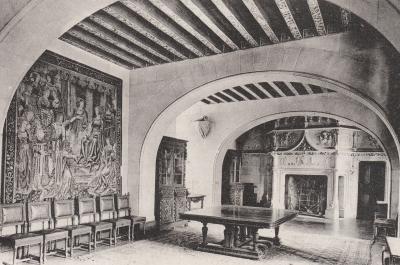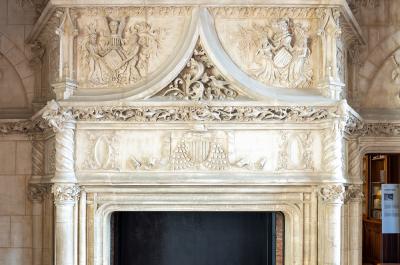This 17-metre-long room was used as a kitchen and for servant's duties. But the de Broglie’s turned it into a dining room, refurbishing it in 15th- and 16th-century styles, with a neo-gothic fireplace and a polychrome ceiling. They installed all the modern comforts of their day, such as running water, electricity and under-floor central heating.
Gabriel-Louis Pringué, a writer and close friend of the Broglie’s, was a regular guest at Chaumont. In his book Trente ans de dîners en ville (30 years of dinners in town), he wrote of a dinner in the de Broglie residence: "Princess Henri-Amédée de Broglie was a woman of unlimited fantasy and awakened whimsy. She detested all rules and discipline. She was unable to subject herself to exactitude. In her château at Chaumont, dinner was arranged for seven-forty-five. Rarely did I see her descend before nine-forty-five. We waited patiently – exquisitely even – amid the sweet and musky scents of mauve orchids which filled the rooms. Madame de Broglie always had about twenty guests staying, some of whom were the height of intelligence, art, elegance, and society. (…) The table would covered with brilliant silverware that sparkled in the light of the ceiling candelabras with eight or ten arms. There would be a centrepiece of greenish-brown orchids. The effect was impressive and matched perfectly the 14th-century high-lice tapestries that hung on the stone walls. The table linen was superb, with the de Broglie coat of arms woven in. (…) Here is the menu of a dinner during a visit by the Duc de Montpensier in December 1913: Queen's creamed soup, calf's sweetbreads à la Maréchale, Loire salmon with its green sauce, Peppered haunch of venison, Chestnut purée, Green salad, Cardoons, Chaud-froid of thrush with grapes, Poached truffles, Pineapple sorbet, and cakes."
The furniture
The de Broglies commissioned the dining-room furniture from leading cabinetmakers. With the sale, in 1938, of some of this furniture, and the museographic refurbishing in 1950, the room gradually lost its "19th century" character and became more Renaissance. To restore some of the château's historical coherence, it was in recent years decided to re-establish the mood that reigned during the de Broglies' ownership.
Several acquisitions were therefore made, like the dresser, dated 1880. The lower section has four doors decorated with sculpted interlace, cartouches and salamanders. Above, are four drawers separated by uprights in small columns. And above all this, is a four-level canopy.
Dressers were used to store crockery, but also to display it. They originated in the 13th century when, to make more room, two chests were placed on top of each other on the cart transporting furniture from residence to residence. It was in the 14th century that the doors of one of the chests was opened to give birth to the dresser. In the 15th century, dressers became more and more elaborate. During feasts with important dignitaries, a host simply had to have one as a showcase for the best tableware, often made of silver or gold.
Going by the Honneurs de la Cour, written in the 15th century by Aliénor de Poitiers for the court of Burgundy, the number of shelves varied depending on the owner's rank amongst the knighthood: five shelves for a sovereign prince or queen; four for the wife of a lowly prince; three for the wife of a count; and two for the wife of a simple knight.
The Domain continues to acquire new pieces of furniture deposited by important institutions like the Mobilier National, the Decorative Arts Museum in Paris and the National Museum of the Middle Ages- Hôtel de Cluny, along with acquisitions made by FRECC (Regional Fund for the Enrichment of Chaumont’s Collections).
The fireplace
It was the de Broglies architect, Paul Ernest Sanson, who designed this neo-gothic fireplace in the late 19th century. It was later sculpted by Antoine Margotin.
With great virtuosity, Sanson included, on the mantel, a large part of the sculpted repertoire from the exterior facades of the château. Above, you can see the arms of Charles the First d’Amboise, owner of the Château until 1481; and those of his son, Charles the Second, who oversaw the work until 1511, respectively held by two angels and two savages. Below, are the arms of Cardinal Georges d’Amboise, framed by the "C" of Charles the Second. On either side, is a mountain in flames – a play on words of the name of the Domain: Chaud meaning "hot" and Mont meaning "mount", as well as the French coat of arms.



